Wild fisheries
A wild fishery is a natural body of water with a sizeable free-ranging fish or other aquatic animal (crustaceans and molluscs) population that can be harvested for its commercial value.The currents are generated from the forces acting upon the water like the planet rotation, the wind, the temperature and salinity (hence isopycnal) differences and the gravitation of the moon.Wind-driven surface currents interact with these gyres and the underwater topography, such as seamounts and the edge of continental shelves, to produce downwellings and upwellings.Regions of upwelling include coastal Peru, Chile, Arabian Sea, western South Africa, eastern New Zealand and the California coast.These are the second level in the food chain, including krill, the larva of fish, squid, lobsters and crabs –as well as the small crustaceans called copepods, and many other types.[23] Combined with the sunlight available in shallow waters, the continental shelves teem with life compared to the biotic desert of the oceans' abyssal plain.[26] They are also restricted along the coast around northeastern South America and Bangladesh due to the release of vast quantities of freshwater from the Amazon and Ganges Rivers respectively.The list of factors is long but includes the oceans acting as a carbon dioxide sink, changes in Earth's atmosphere, ultraviolet light, ocean acidification, biological virus, impacts of dust storms carrying agents to far flung reef systems, various pollutants, impacts of algal blooms and others.Reefs are threatened well beyond coastal areas and so the problem is broader than factors from land development and pollution though those are too causing considerable damage.Inhabitants of Ahus Island, Manus Province, Papua New Guinea, have followed a generations-old practice of restricting fishing in six areas of their reef lagoon.For a long time it has been surmised that many pelagic animals visit seamounts to gather food, but proof this of this aggregating effect has been lacking.The first demonstration of this conjecture has recently been published [42] During the 1960s, Russia, Australia and New Zealand started to look for new stocks of fish and began to trawl the seamounts.[43] tuna billfish shark herring sardine anchovy menhaden cod flatfish Worldwide, freshwater lakes have an area of 1.5 million square kilometres.Deoxygenation and eutrophication are two major effects that are detrimental to fish and ecosystem health and the problem is more prevalent as the size of the body of water decreases.Wild fisheries flourish in oceans, lakes, and rivers, and the introduction of contaminants is an issue of concern, especially as regards plastics, pesticides, heavy metals, and other industrial and agricultural pollutants which do not disintegrate rapidly in the environment.[48] Plastics accumulate because they don't biodegrade as many other substances do; while they will photodegrade on exposure to the sun, they do so only under dry conditions, as water inhibits this process.They strongly resemble fish eggs, only instead of finding a nutritious meal, any marine wildlife that ingests them will likely starve, be poisoned and die.[55] Plastic debris, when bulky or tangled, is difficult to pass, and may become permanently lodged in the digestive tracts of these animals, blocking the passage of food and causing death through starvation or infection.[56] Tiny floating particles also resemble zooplankton, which can lead filter feeders to consume them and cause them to enter the ocean food chain.In samples taken from the North Pacific Gyre in 1999 by the Algalita Marine Research Foundation, the mass of plastic exceeded that of zooplankton by a factor of six.[48] Hydrophobic contaminants are also known to bioaccumulate in fatty tissues, biomagnifying up the food chain and putting great pressure on apex predators.It can result in an increase in the ecosystem's primary productivity (excessive plant growth and decay), and further effects including lack of oxygen and severe reductions in water quality, fish, and other animal populations.[73] Estuaries also tend to be naturally eutrophic because land-derived nutrients are concentrated where run-off enters the marine environment in a confined channel.A study in 2008 found that this could account for around one third of the ocean's external (non-recycled) nitrogen supply and up to three per cent of the annual new marine biological production.[78][79] The potential consequences of ocean acidification are not fully understood, but there are concerns that structures made of calcium carbonate may become vulnerable to dissolution, affecting corals and the ability of shellfish to form shells.[80] A report from NOAA scientists published in the journal Science in May 2008 found that large amounts of relatively acidified water are upwelling to within four miles of the Pacific continental shelf area of North America.Numerous habitats and ecosystems are disturbed and destroyed by trawling including coral reefs, sediments, and grasses that provide feeding and breeding grounds for a plethora of marine organisms.Our World in Data provides a figure showing the trend in global fishing exploitation over a few decades to reveal the intensifying circumstances at hand:Waters are polluted or extracted at high levels, wetlands are drained, rivers channelled, forests deforestated leading to sedimentation, invasive species are introduced, and over-harvesting occurs.[89] A recent paper published by the National Academy of Sciences of the USA warns that: "Synergistic effects of habitat destruction, overfishing, introduced species, warming, acidification, toxins, and massive runoff of nutrients are transforming once complex ecosystems like coral reefs and kelp forests into monotonous level bottoms, transforming clear and productive coastal seas into anoxic dead zones, and transforming complex food webs topped by big animals into simplified, microbially dominated ecosystems with boom and bust cycles of toxic dinoflagellate blooms, jellyfish, and disease".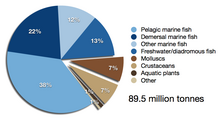
Global wild fish capture in million tonnes, 2010, as reported by the FAO
[
1
]
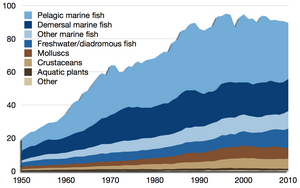
Global wild fish capture in million tonnes, 1950–2010, as reported by the FAO
[
1
]
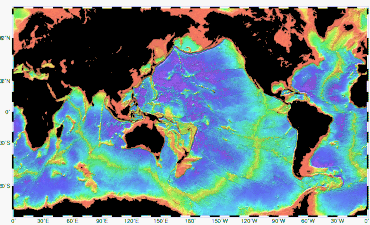
Bathymetry
of the ocean floor showing the
continental shelves
and
oceanic plateaus
(red), the
mid-ocean ridges
(yellow-green) and the
abyssal plains
(blue to purple)

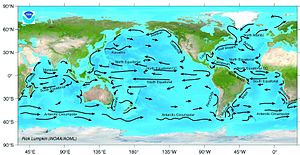
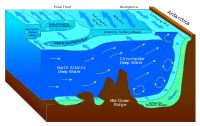

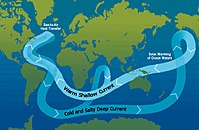
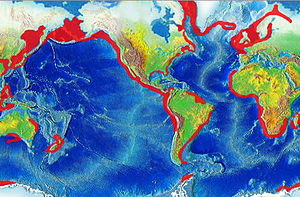



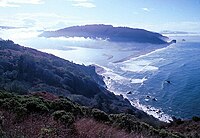
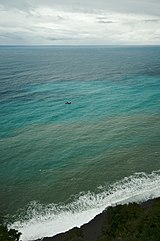
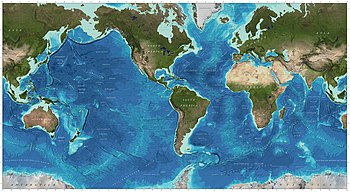
Global continental shelf, highlighted in light green

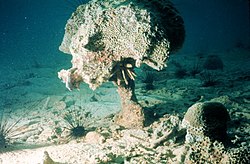
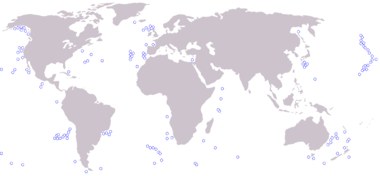

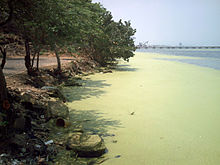
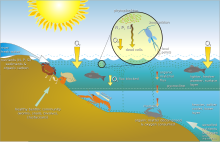
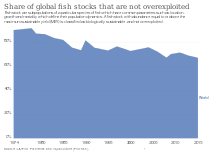
North Frisian IslandsNorth Seafisherynaturalbody of wateraquatic animalcrustaceansmolluscsharvestedfisheriesmarinesaltwaterlacustrineriverinefreshwatercarrying capacityaquatic ecosystemcoastscontinental shelvesriversoverfishingpollutionfarmed fisheriesfish tanksaquacultureChinesefood sourceWorld fish productionFishing by countryFood and Agriculture Organizationworld harvestcommercial fisheriestonnesaquatic animalsaquatic plantsseaweedfish farmsBathymetryoceanic plateausmid-ocean ridgesabyssal plainsmarine topographyocean currentsAutomatic Identification Dataestuariesshorelinescoral reefsdeep seaseamountsocean currentocean watertemperaturesalinityisopycnalgravitation of the moondepth contoursshorelineSouthern OceanthermohalineEkman spiralseasonsThermohaline circulationocean basinUpwellingdownwellinglife-cycle of the eelmarine debrisOceanic gyresCoriolis effectupwellingsforage fishArabian SeaSouth AfricaNew ZealandCaliforniaHumboldt Currentmarine lifepelagicsardinesanchoviesjack mackerelCalifornia CurrentPacific OceancurrentNorth AmericaBritish ColumbiaBaja CaliforniacoastallatitudeUnited StatesEkman EffectwhalesseabirdsEl Niñophytoplanktonbiomassphotosynthesisprimary productionSeaWiFSGoddard Space Flight CenterORBIMAGEfood chainfilter feedersprimary producertrophic levelprotoplasmzooplanktoncopepodssatellitenormalised difference vegetation indexchlorophyllphotoautotrophicstanding stocksautotrophsanimalAntarctic krillEcosystemOpen oceanContinental shelfAlgal bedsmangrovesstreamsWhittaker, R. H.Likens, G. E.ecoregionsWorldwide Fund for Nature